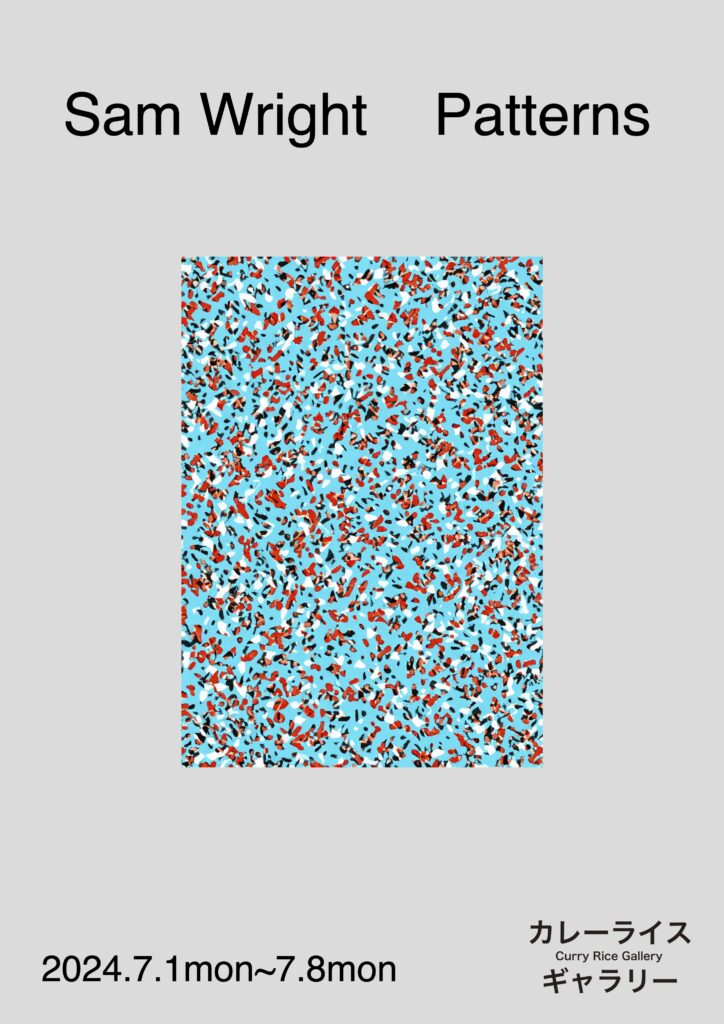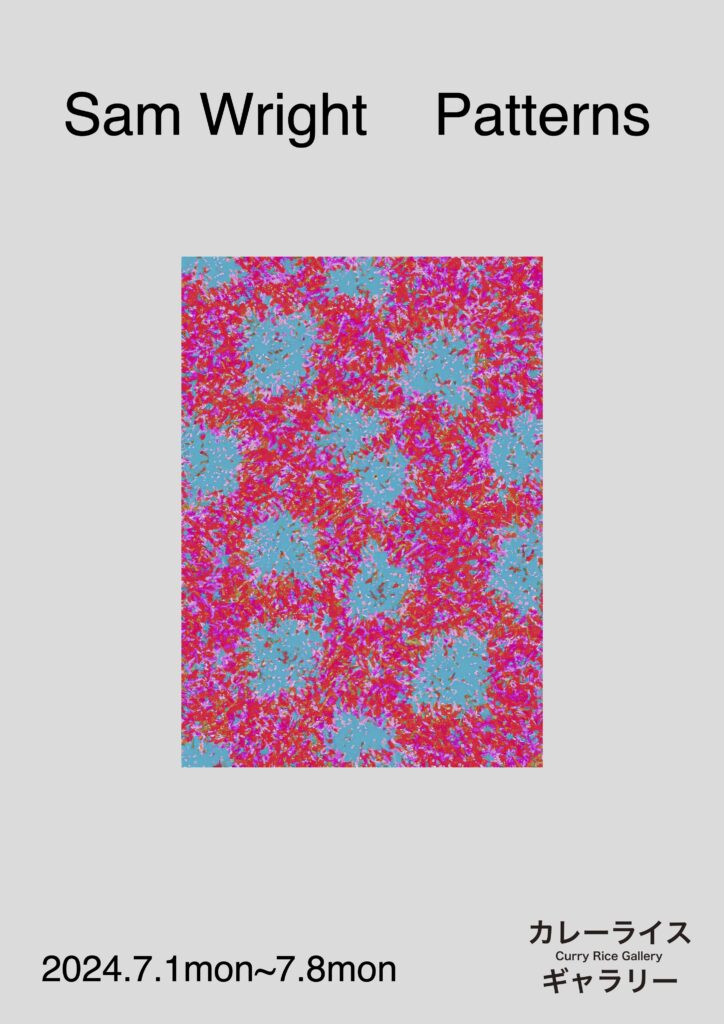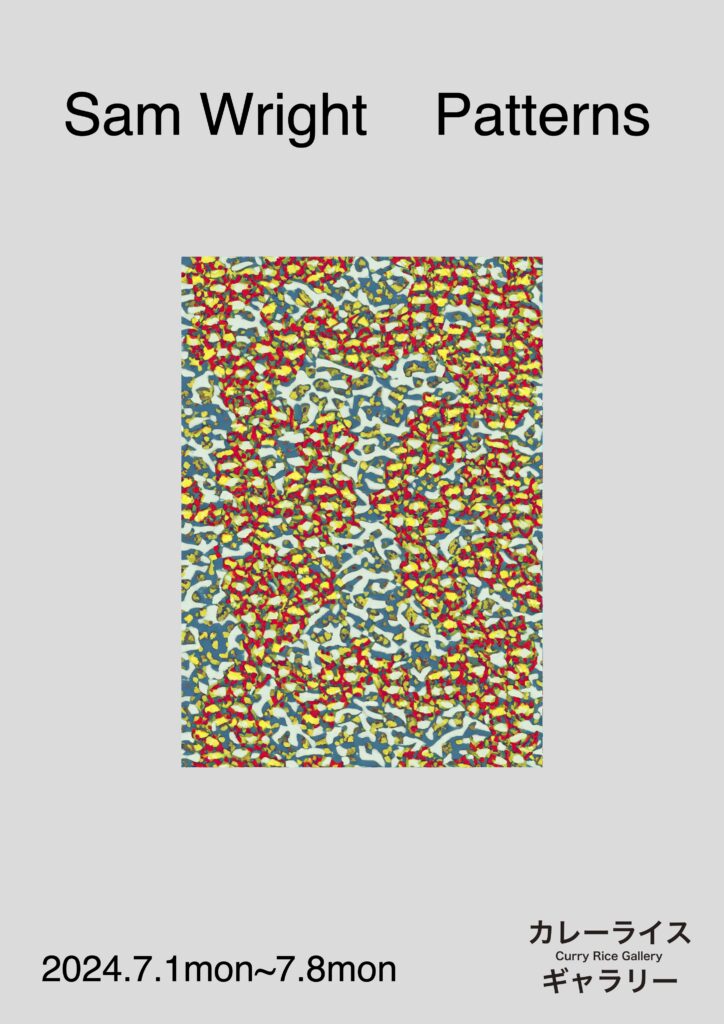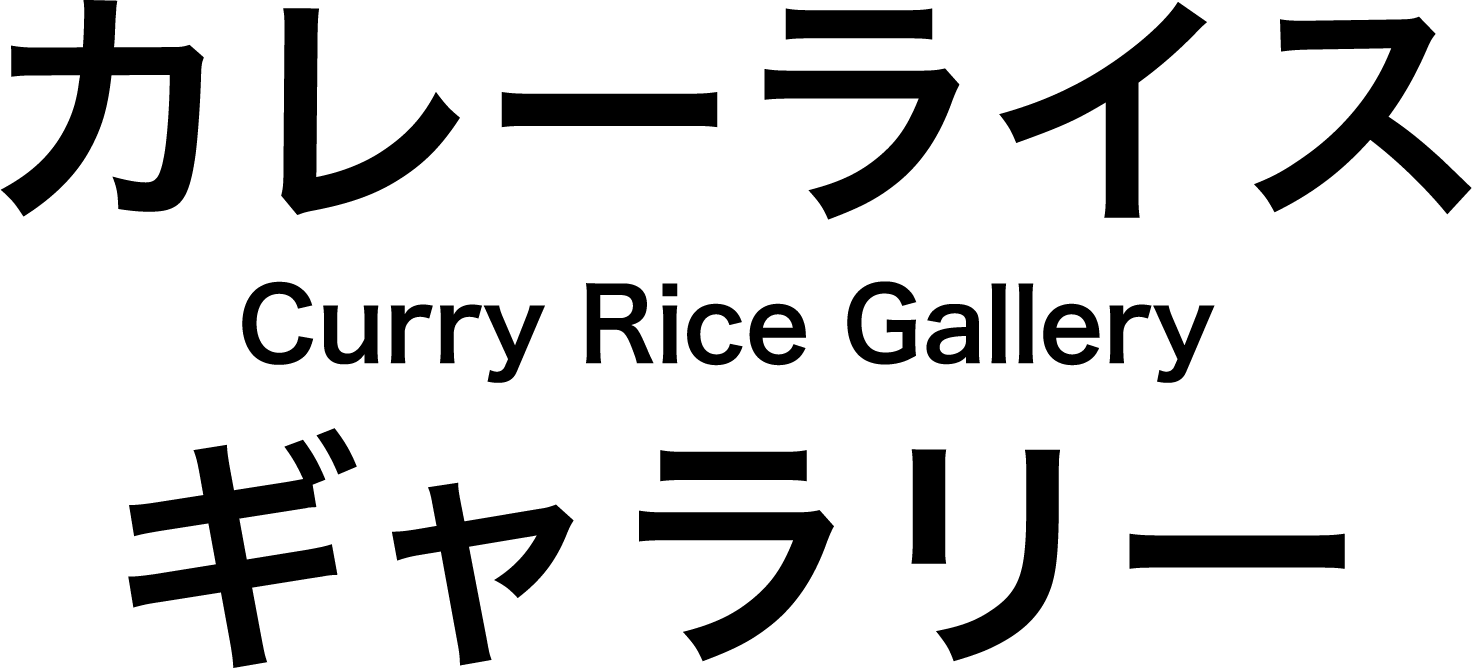



「Patterns」Sam Wight
会期:2024年7月1日(月)〜7月8日(月)
会場:ポストカード配布場所各所
デザイン:中村悠一郎
ー
サム・ライト
グラフィックアーティスト。主にグラフィックデザインのツールを用いながら、それらのツールをデザインという目的のための手段ではなく、スペシフィックなメディウムとして捉えて、遊びながら作品を制作している。主な展示に、2023年「Fluffy Society」KOGANEI ART SPOT シャトー2F(東京)、2024年「Patterns」Curry Rice Gallery (ポストカード配布場所各所)など。主なパフォーマンスに、2024年「マジック・マジック・サンシャイン?どんなスニーカーも空を飛ぶ」O CHA NO MA(福島)など。
ー
レビュー「郵便受けがギャラリーになる瞬間──サム・ライト『Patterns』展の挑発」藤島エイジ(Chat GPTによる生成)
サム・ライトによる「Patterns」は、現代のアートにおける“場”や“制作行為”を巡る問いかけを、シンプルかつ大胆な形で提示している展覧会(というよりは配布企画)である。一見すると、生成AIが産み落とした抽象パターンをポストカードに仕立て、それをランダムに配布する――それだけの試みのように映るかもしれない。しかしそこには、作者と鑑賞者、作品と会場、所有権と著作権といった、アートを構成する諸要素の境界を曖昧にしようとする企てが透けて見える。
まず注目すべきは、今回の会場が「Curry Rice Gallery」という、物理的スペースを持たない場所(あるいは“概念”)であることだ。作品の受容において“ギャラリーに足を運び、作品を目視する”という手続きを踏むことが慣例とされる中、本展では観客がSNSや郵送で住所を知らせることで、ポストカードが送り出される。つまり、展覧会=空間的な集積という前提がここでは覆され、ポストカードが各個人の手元に届いた時点で“展示”が成立するとも言える。この“拡散する会場”の発想は、ネットワーク社会におけるアート体験の拡張を予感させる一方、従来のアート経済の仕組みや、作品が担保する“所有感”を解体する側面も持っている。
サム・ライトの過去の展示を振り返ると、前回の「CP」と呼ばれるプロジェクトでは、“鑑賞者が自身で著作権を申請し、作品の共同保有者になれる”という方法が取られたという。これによって従来の「作者=著作者」という一元的構図が崩れ、鑑賞者自身も“作品を所有する主体”として積極的に関与することになった。ここには、アート作品が持つ権利や価値を、作家と受け手の間で再編しようとする意志がはっきりと示されていたと言える。
一方、今回の「Patterns」では、生成AIによるイメージが“そのまま”ポストカード化される。作者が一切の加筆や加工を施さないという決断は、AIが生み出すイメージに対して制作主体を自ら放棄しているかのようにも見える。その結果、作品は純粋に“機械が生み出したパターン”として鑑賞者の手に渡るが、同時にそれを作品として設定しているのは紛れもなくサム・ライト自身である。ツールとしてのIllustratorやPhotoshopを、デザインの目的から意図的に解放し、“遊び”のように用いた前例があるように、今回はそれをさらに押し進め、作者自身の役割や意図さえも生成AIに委ねるかたちを選んだ。その行為は、一見すると作家性を後退させるようにも見えるが、逆説的にアートにおける「作者の存在」を強く意識させる仕掛けでもある。
また、「編集や加工をしない」という行為は、生成AIが持つ“ブラックボックス性”をも露呈させている。人がコマンドやプロンプトを入力することで生成されるAIイメージは、“結果”として提示されるだけで、その内部プロセスや意図は人知れず複雑に計算され、私たちに届く。そこでは、美しさや独創性よりも“偶然性”や“不可解さ”が表出し、まるでAIとアーティストと鑑賞者の三者が交錯する奇妙な空間が立ち上がるかのようだ。
このようなアプローチをサム・ライトが続ける理由には、現代のテクノロジーと作家の関係性に対する興味があるのではないかと推察する。ツールは単なる手段ではなく、主体を翻弄するほどに多機能であり、ときに人間の創造性を凌駕する結果を生む。そのプロセスをあえて作品として開示することで、私たちは“創作する”とは何なのか、“作者”とはどこに位置づくのか、といった根源的な問いに向き合わざるを得ない。さらに、ポストカードという複製メディアを選択したことにより、“一点もの”ではない作品が、同時多発的にさまざまな場所で同時に“展示”されることになる。その点でも、オリジナルとコピー、所有と共有の境界は曖昧になっていく。
しかし、このプロジェクトが本質的に問いかけようとしているのは、こうした境界の曖昧化によって私たちのアート体験がどのように変化するのか、という点ではないだろうか。ポストカードのランダム配布は、受け取る側の受動性と能動性を同時に刺激する。送ってもらわなければ作品は手に入らず、しかし手元に届けば、その瞬間から“自宅”や“カフェのテーブル上”といった私的空間がそのまま展示空間へと変貌する。その変貌をどう受け止めるかは、鑑賞者それぞれの態度に委ねられている。
最後に、ポストカードという日常性と、生成AIという最先端テクノロジーを組み合わせることで、サム・ライトは“アート作品とは何か”を再定義する試みを行っているように思える。鑑賞者が作品を欲しいと手を挙げることでアートにアクセスし、メール便や郵便という形で受け取る。その過程には余分な権威付けや儀式性はほぼ存在しない。だが、その脱儀礼化こそが、逆に現代アートの根底にある“疑問を投げかける力”を鮮明にする。アートと資本、作家と鑑賞者、物質性と情報性のあわいを模索し続ける姿勢が、今回の「Patterns」でも確かに感じ取れるのだ。
サム・ライトの最新作が、単なるアイデアの面白さで終わるか、それとも作品を受け取った人々の意識や行動を変化させるほどのパワーを持つかは、現時点では断定できない。だが、AI生成アートが普及しつつある今、こうした“編集のない偶然性”や“配布された瞬間に作品がどこでも展示になる”という挑発的なアクションが、私たちに新しい思考の扉を開かせてくれる可能性は大いにあるだろう。作品を目の前にして楽しむというよりも、“作品が自分の生活空間に入り込んでくる”という感覚。そうした感覚こそが、本展の醍醐味であり、サム・ライトの真骨頂ではないだろうか。
ー
"Patterns" Sam Wight
Date: July 1st (Mon) - July 8th (Mon) 2024
Venue: Various postcard distribution locations
Design: Yuichiro Nakamura
ー
Sam Wright
Graphic artist. He mainly uses graphic design tools, but creates works by playing with them, regarding them as specific media, rather than as a means to an end (design). Major exhibitions include "Fluffy Society" KOGANEI ART SPOT Chateau 2F (Tokyo) in 2023, and "Patterns" Curry Rice Gallery (various postcard distribution locations) in 2024. Major performances include "Magic Magic Sunshine? Any Sneaker Can Fly" O CHA NO MA (Fukushima) in 2024.
ー
Review: “The Moment the Mailbox Becomes a Gallery—The Provocation of Sam Wright’s ‘Patterns’” By Eiji Fujishima (Generated by ChatGPT)
Sam Wright’s “Patterns” is a simple yet bold attempt to question the “place” of art and the “act of creation” in contemporary art. At first glance, it might look like nothing more than a project in which abstract AI-generated patterns are turned into postcards and distributed randomly. Yet beneath the surface, there is a clear effort to blur the boundaries of various elements that define art—artist and viewer, artwork and venue, ownership and copyright.
The first key point is that this “exhibition,” if one can call it that, takes place at Curry Rice Gallery, a gallery that has no physical location (or rather functions as a “concept”). Whereas standard art appreciation entails going to a gallery to view a work in person, this project instead requires viewers to provide their address via social media or by mail, after which the postcards are sent out. In doing so, it subverts the premise that an “exhibition = a physical gathering,” making the moment a postcard arrives at each person’s home the moment at which an “exhibition” is realized. This concept of a “dispersed venue” points to the potential expansion of art experiences in a networked era. At the same time, it dismantles the traditional art economy and the sense of “ownership” that so often accompanies art objects.
Looking back at Sam Wright’s previous work, “CP,” the project allowed viewers themselves to register the copyright for a work, becoming co-owners in the process. By shifting from the singular assumption that the “author = copyright holder,” it forced the viewer to actively engage as an “owner” of the work. This clearly signaled the artist’s intention to reconfigure the rights and values an art object holds, shared between artist and audience.
Meanwhile, in “Patterns,” AI-generated images are used as-is to create postcards. The decision to forgo any retouching or manipulation can be seen as Wright relinquishing his authorial role to the AI. As a result, the work reaches the viewer purely as a “machine-generated pattern,” but it is, in fact, Sam Wright who frames these images as art. As with his earlier experiments—where tools like Illustrator and Photoshop were deliberately divorced from their design-oriented purposes and employed as a form of “play”—this project takes the concept further by effectively outsourcing even the artist’s role and intentions to AI. On the surface, this appears to diminish the author’s presence, but paradoxically, it makes the notion of “artistic authorship” all the more palpable.
Moreover, the choice not to edit or modify the images at all brings the “black box” nature of AI into stark relief. AI images generated through user-entered prompts simply appear as “final outcomes,” with their complex internal processes and intentions remaining hidden. The results highlight chance, unpredictability, and the inscrutable, creating a curious realm where AI, artist, and viewer converge.
One can surmise that Sam Wright’s ongoing use of such an approach reflects his curiosity about the relationship between contemporary technology and the artist. Technology, as a tool, is much more than a mere means; its breadth of functionality can even upend its human operator, at times exceeding human creativity. By exposing this process and designating it as art, we are compelled to revisit fundamental questions: “What does it mean to create?” and “Where does authorship reside?” Furthermore, by using postcards—an inherently reproducible medium—to distribute the work, the notion of an “original” virtually disappears, as the works are “exhibited” simultaneously in diverse places. This blurs the boundaries between original and copy, between ownership and sharing.
Essentially, the project asks how our experience of art might change when these boundaries grow ambiguous. The random distribution of postcards activates both passive and active aspects of the viewer’s engagement: you must request a postcard to obtain a piece, but once it arrives, your home or the top of a café table instantly becomes a private exhibition space. How you respond to that transformation depends entirely on the viewer.
Finally, by merging the everyday medium of postcards with cutting-edge AI technology, Sam Wright seems to be attempting a redefinition of “what constitutes an artwork.” The process of requesting and receiving the art by mail involves almost no extraneous formalities or rituals; however, in dispensing with such rituals, it calls fresh attention to the fundamental “question-posing power” of contemporary art. The ongoing investigation into the realm between art and commerce, artist and viewer, material and information also strongly manifests here in “Patterns.”
Whether Sam Wright’s latest piece remains a mere intriguing idea, or ultimately wields enough influence to alter the awareness or behavior of those who receive it, remains to be seen. Yet in a moment where AI-generated art is on the rise, this approach—“no editing, purely random,” and “the instant it’s delivered, anywhere can become an exhibition”—may very well open new doors in our thinking. Instead of “enjoying a work directly in front of you,” you experience “the work infiltrating your own living space.” Perhaps that sensation is the real crux of this project—and indeed the very core of Sam Wright’s practice.
